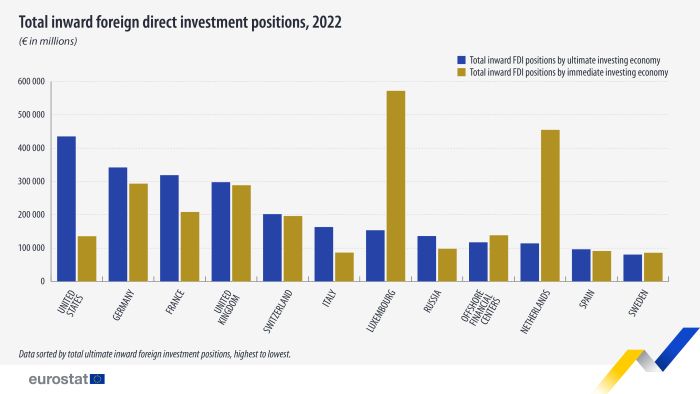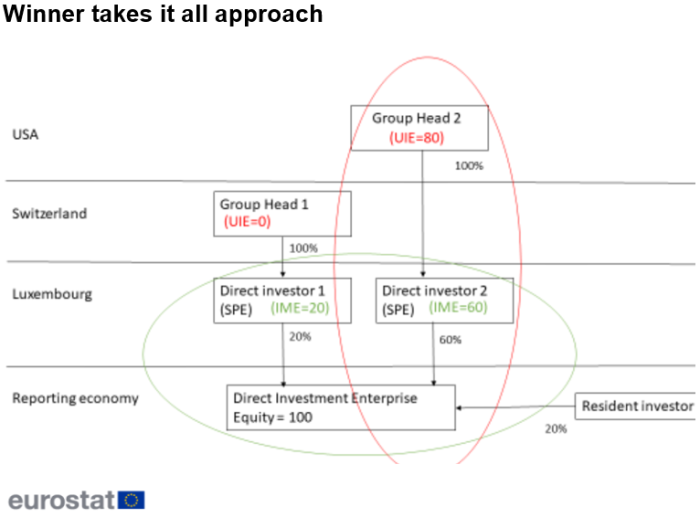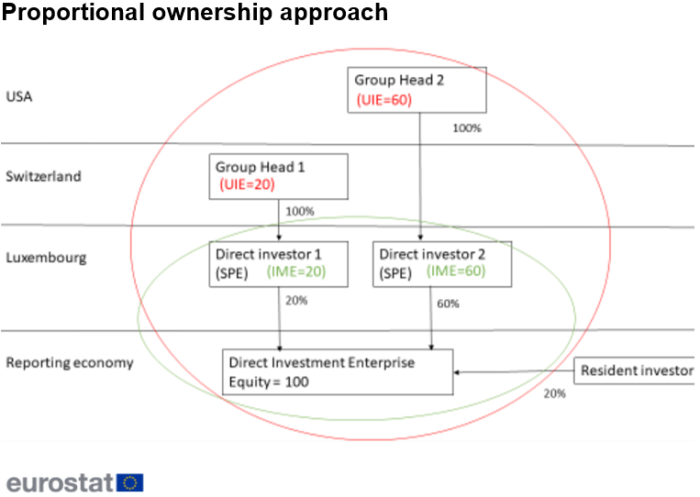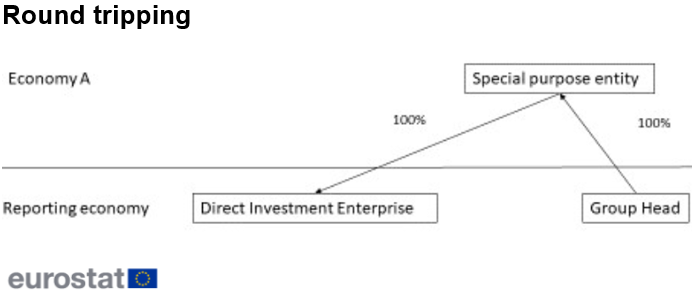Foreign direct investment positions by ultimate counterpart
Data extracted in January 2024
Planned article update: January 2025
Highlights
In 2022, for the 11 EU Member States that reported inward Ultimate Investing Economy in Foreign Direct Investment positions, the top UIE was the United States, (13.4% of total value of UIE FDI positions of the 11 reporting countries), followed by Germany (10.5%).

Source: Eurostat (bop_fdi6_pos)
Eurostat collects inward Foreign Direct Investment (FDI) positions according to the Ultimate Investing Economy (UIE) on a voluntary basis. The standard FDI statistics laid down in the Regulation (EC) No 184/2005 are compiled by immediate investing economy (country) whereas the UIE FDI positions facilitate users' analysis in determining the location of the ultimate source of control of the FDI positions in their direct investment enterprises. While the identification of the immediate investing economy is generally straightforward, that of the UIE is more complex and requires an overview of the ownership links of the Multinational Enterprises.
Full article
Locations of the ultimate investors in direct investment enterprises
There is ample interest by policy makers in political, economic, and structural analysis to identify the locations of the ultimate investors in direct investment enterprises. This interest has grown in recent years, as ownership structures have become more complex and as it has become more common for direct investment enterprises to be owned through intermediate entities such as holding companies.
In 2022, for the eleven EU Member States: Cyprus, Czechia, Denmark, Estonia, Spain, Finland, France, Greece, Italy, Portugal and Romania, which reported inward UIE FDI positions to Eurostat, the top investors were concentrated among a relatively small number of developed countries. As shown in Figure 1, the top UIE was the United States, (13.4 % of the total value of UIE FDI positions of the 11 reporting countries), followed by Germany (10.5 %), France (9.8 %), the United Kingdom (9.2 %) and Switzerland (6.2 %).
Luxembourg was the top investor by immediate investing economy (17.6 % of the total FDI positions of the 11 reporting countries), followed by the Netherlands (14.0 %), Germany (9.0 %), the United Kingdom (8.9 %) and France (6.4 %). This shows that Luxembourg and the Netherlands are often used as 'pass-through' countries in international investment chains.

Source: Eurostat (bop_fdi6_pos)
Compilation of UIE FDI positions
There are two generally recommended methodological approaches to compile UIE FDI statistics: the 'winner takes it all' approach and the 'proportional ownership' approach (described in the OECD Benchmark Definition of FDI, 4th edition, 2008, Annex 10). The difference between the two approaches is illustrated in Figure 2 and Figure 3. Compiling UIE FDI statistics according to the 'winner takes it all' approach only allows for one UIE, which is the one controlling the direct investment enterprise. In Figure 2, the full FDI position (80) is allocated to the ultimate investor in the United States.
Using the 'proportional ownership' approach allows for multiple UIEs and as illustrated in Figure 3, the UIE FDI position would be split between Switzerland (20) and the United States (60).
The proportional ownership approach has the advantage that it is more consistent with FDI statistics, where the values of the variables reported are based on each foreign investor's claim on the direct investment enterprise. However, many countries prefer to compile UIE FDI statistics using the 'winner takes it all' approach, as it is often easier to obtain information about the controlling investor of the enterprise than the minority investors.
As opposed to the standard FDI statistics, the UIE FDI allows for the reporting economy to also invest in itself (so-called 'round-tripping'). This is illustrated in Figure 4 and happens frequently in international investment chains for various reasons such as tax and fiscal advantages and property right protection.
Source data for tables and graphs
Data sources
EU FDI data are collected by Member States' Balance of Payments compilers through a variety of sources. The main types of sources used are direct surveys addressed to resident statistical units and reports by the central banking systems on international transactions. The 11 EU Member States: Cyprus, Czechia, Denmark, Estonia, Spain, Finland, France, Greece, Italy, Portugal and Romania, reported inward UIE FDI positions to Eurostat on a voluntary basis for the reference year 2022.
Context
FDI encompasses all kinds of cross-border investments made by an entity resident in one economy (direct investor) to acquire a lasting interest in an enterprise operating in another economy (direct investment enterprise). The globalisation of the world economy therefore creates new needs for statistics. In addition to the standard FDI statistics laid down in the Regulation (EC) No 184/2005 compiled by immediate investing economy (country), the UIE FDI positions statistics are currently provided by 15 countries on voluntary basis (including Norway, Türkiye, and two additional EU Member States: Germany and Hungary that provided data up to reference year 2021).
Direct access to
- Balance of payments – International transactions (BPM6) (bop_6), see:
- European Union direct investments (BPM6) (bop_fdi6)
Metadata
- Balance of payments – international transactions (BPM6) (ESMS metadata file – bop_6_esms)
- European Union direct investments (BPM6) (ESMS metadata file – bop_fdi6_esms)
Further methodological information


